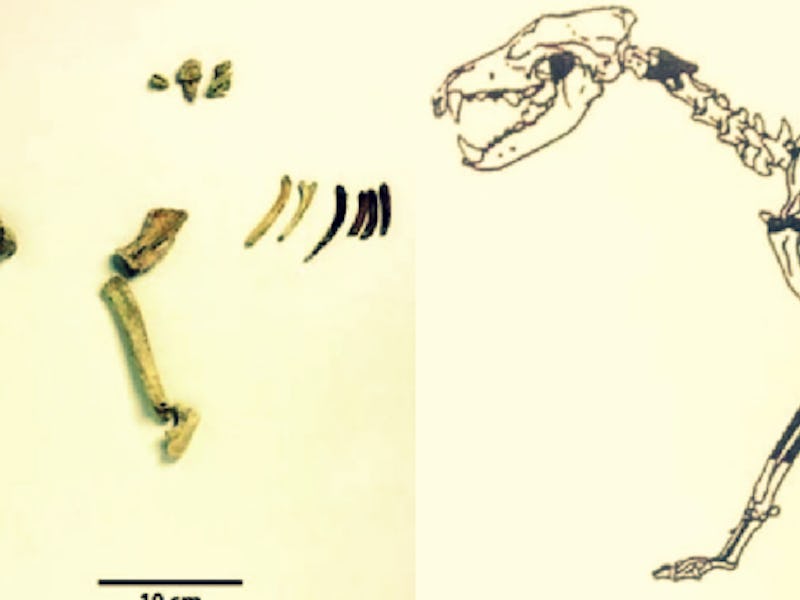Ancient Canine Skeleton Reveals New Depths of Humanity's Bond With Dogs
'There was a unique relationship of care between humans and dogs.'

A pup’s sweet glance is all your heart really needs, but scientists have now proven that people have emotional ties to dogs, and very good boys bond with us in return. Now, a new study in the Journal of Archaeological Science puts a date on the origins of that bond, shedding light on the nature of our early relationship with pups.
The paper, published Saturday in the Journal of Archeological Science, presents a new analysis on dog remains discovered in 1914 near Bonn, Germany. These bones and teeth were found alongside the remains of two humans and the teeth belonging to another dog, making the site the oldest known grave in which humans and dogs were buried together. The fossils are thought to be 14,000 years old, suggesting that our sweet sentiments toward dogs originated in the Paleolithic era.
The teeth of the younger dog from the grave, with traces of canine distemper.
This revelation isn’t just adorable; it also revealed that the relationship between dogs and ancient humans didn’t only form out of necessity. Dogs helped us hunt, sure, but the analysis of the fossils showed that early puppers endeared themselves to their owners as well.
As scientists re-examined the teeth that belonged to the more complete dog fossil, they discovered it was only about seven months old when it died. But when veterinarian and Leiden University Ph.D. candidate Luc Janssens took a closer look at the teeth, he realized that the dog survived much longer than it would have without human help: The dog appeared to have suffered from an infection with morbillivirus, colloquially known as canine distemper. Even now, this virus has no known cure.
While Janssen notes that the team can’t be 100 percent certain the dog had the virus, the available evidence points to that conclusion. The teeth have characteristic damage showing that the dog became sick when it was only three to four months old, yet it continued to live for another eight weeks — a feat that could have only been managed with the help of a human.
“That would mean keeping it warm and clean and giving it food and water, even though, while it was sick, the dog would not have been of any practical use as a working animal,” Janssen explained in a statement released Saturday. “This, together with the fact that the dogs were buried with people who we may assume were their owners, suggests that there was a unique relationship of care between humans and dogs as long as 14,000 years ago.”
Overview of the bone fragments of the dog found in the grave in Bonn-Oberkassel.
Scientists have been trying to understand when exactly our relationship with dogs began — and when it turned into an emotional bond — for a long time. They generally agree that European dogs were domesticated between 18,000 to 32,000 years ago, in part because ancient humans needed to use them as hunting tools. That process led to selection for dog genes that underlie hyper-social behavior, which likely made bonding easier over the years. In 2017, a team of scientists from the Max Planck Institute reported they found cave art in the Arabian Peninsula depicting dogs on leashes, which scientists determined was 8,000 to 9,000 years old. That discovery was a huge step in understanding the origins of our relationship with dogs, but this new finding sets that relationship back even further on humanity’s timeline. Dogs have been good boys for a while, and archeological evidence is increasingly proving that.